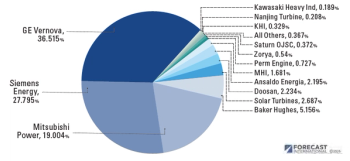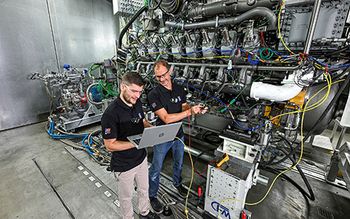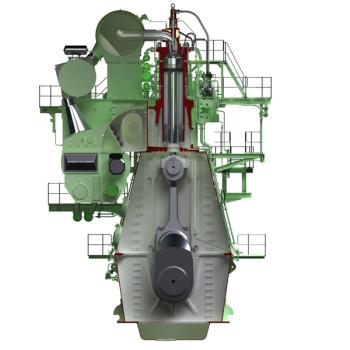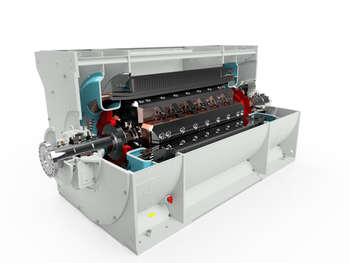
- March/April 2022
Myth: A Compressor is a Pipe Anchor
Every compressor is connected via two or more nozzles with flanges to its suction, discharge, and side-load piping. These pipes, due to flange misalignment or thermal pipe expansion/contraction, can exert significant loads on the compressor flanges. Flange loads, in the form of directly acting static and dynamic multi-directional forces and moments, can cause excessive strain on the nozzles, deflection of the casing, shaft misalignment, and even excessive stress on the equipment and foundation bolts.
For very stiff compressor casings, excessive flange loads usually result in shaft misalignment between the compressor and the driver since the loads ultimately must be carried by the skid bolting – the less stiff interface between the foundation and the dynamic equipment. For lighter compressor casings with lower stiffness, critical internal clearances between rotating and stationary components can be affected. In these cases, flange loads on the nozzles can lead to internal casing or bundle deformation and failure of single-digit-mil clearance components such as dry gas seals and bearings. They may even result in impeller rub.
Compressor vendors often use multiple times the allowable NEMA or API requirements as their design standard. These requirements include NEMA SM-21, the subsequent NEMA SM-24 and the calculation method published in Appendix E of American Petroleum Institute 617. A common multiplier is 3.0 times API 617 (equal to 5.55 times NEMA) as allowable load limits. Similarly, API flange load limits are equal to 1.85 times NEMA. Although NEMA is a steam turbine standard, it is commonly used for flange load calculations on other rotating machinery.
Alternatively, rather than relying on the somewhat arbitrary use of fixed multiples of API or NEMA, many vendors ask the equipment end user to supply pipe flange loads for review and approval prior to design and fabrication of the equipment. However, it is often difficult to accurately predict flange loads before final construction of the compression piping system. Though good pipe design software is commercially available, as-built construction errors and pipe installation misalignments are common.
Regardless, the aim of both the vendor and the user of rotating machinery should be to design equipment and piping that reduces the actual load on the compressor nozzles and casing. The compressor should not be an anchor point for poorly designed piping. Compressors are expensive and complex dynamic machines that are not intended to take the function of relatively inexpensive pipe supports/loops or correct for piping system design errors. API 617 states, “The design of each compressor body must allow for limited piping loads on the various casing nozzles. For maximum system reliability, nozzle loads imposed by piping should be as low as possible regardless of the compressor’s machines’ load-carrying capability.”
Rather than imposing unreasonable flange load requirements, the piping designer should either fix the piping to reduce unnecessary weights and thermal expansion loads or include additional pipe support structural members or thermal loops. The compressor is a finely aligned machine already subject to a range of internal dynamic loads. Any excessive external static loads from pipe misalignment have the potential to lead to operational/maintenance problems and long-term damage.
But reality in the field is often unpredictable and does not always follow the wishes of the compressor and piping layout designer. We have seen cases where the piping was so poorly aligned with the compressor flange that a large bulldozer was required to pull the pipe to get the flange bolt holes to align.
These static loads – and any further thermal expansion/contraction loads – imposed on the nozzle should be corrected by fixing the piping system rather than forcing the compressor to become a static structural node of the system. In other words, instead of imposing expensive flange load requirements on the compressor vendor, piping design and installation should aim to reduce these loads. It is generally cheaper to build pipe supports, structures and loops than to redesign a compressor or hope that stress on the compressor casing doesn’t affect alignment and internals. Remember that the more stress applied on the nozzles, the more difficult alignment with the driver becomes, and the more stress the skid and foundation bolts must carry.
Obviously, there are some cases where minimizing flange loads is difficult – in space-limited plants or where the foundation is flexible. On an offshore platform or marine vessel, for example, it is often difficult to eliminate all relative movement between the compressor and the interconnected piping. But even in these cases, good engineering practices, such as three-point mounts and sub-skids for added stiffness, should be used to minimize skid deflections and associated nozzle loads.
Compressors will always be required to handle significant nozzle flange loads. That is the nature of fitting and interconnecting pressurized machines into a complex piping system. However, the current industry trend of asking manufacturers to design compressors with higher and higher flange loading capabilities runs counter to good engineering practices. It is more efficient and less costly to focus on the proper design of the piping to reduce flange loads than making the compressor a pipe anchor.
Klaus Brun is the Director of R&D at Elliott Group. He is also the past Chair of the Board of Directors of the ASME International Gas Turbine Institute and the IGTI Oil & Gas applications committee.
Rainer Kurz is the Manager of Gas Compressor Engineering at Solar Turbines Incorporated in San Diego, CA. He is an ASME Fellow since 2003 and the past chair of the IGTI Oil and Gas Applications Committee.
Articles in this issue
over 3 years ago
Should Gear Units Be Used Or Avoided?over 3 years ago
Turboexpander Protectionover 3 years ago
Dry Gas Seal Failure Modesover 3 years ago
Compressor performance and thermodynamicsover 3 years ago
Direct turbomachinery controlsover 3 years ago
Design and Engineering SoftwareNewsletter
Power your knowledge with the latest in turbine technology, engineering advances, and energy solutions—subscribe to Turbomachinery International today.





